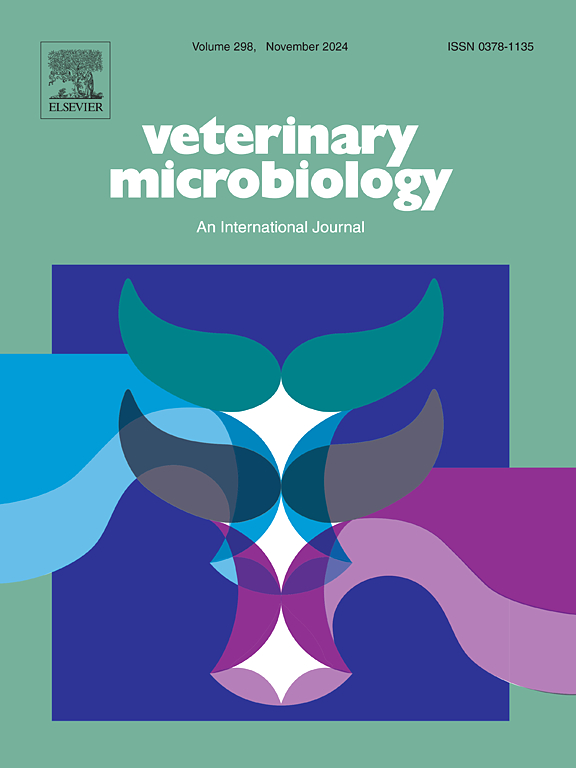Emergence and traceability of Salmonella enterica serotype Mbandaka harboring blaOXA-10 from chickens in China
IF 2.4
2区 农林科学
Q3 MICROBIOLOGY
引用次数: 0
Abstract
Salmonella enterica serotype Mbandaka (S. Mbandaka), a multi-host adapted non-typhoidal Salmonella, has emerged as a significant public health concern in recent years. In this study, we isolated S. Mbandaka strains carrying a multidrug-resistant IncHI2A/IncHI2 plasmid from deceased chickens in China and performed whole-genome sequencing and comparative genomic analyses to investigate their global dissemination and evolutionary adaptation. The multidrug-resistant IncHI2A/IncHI2 plasmid in isolate YK35 harbored multiple antibiotic resistance genes (ARGs) including blaOXA-10, which was firstly observed in S. Mbandaka in China. It exhibited high sequence identity with IncHI2A/IncHI2 plasmids identified in other bacterial species, including S. Typhimurium, Klebsiella aerogenes, and E. coli, which suggested the cross-species dissemination of IncHI2A/IncHI2 plasmids and ARGs. Global genomic epidemiology classified S. Mbandaka strains into seven distinct clades, with the majority originating from the USA and the UK. The pan-genomic analysis indicated an open pan-genome structure, with continuous expansion of accessory genes, particularly those associated with replication, recombination, repair, and defense mechanisms, underscoring the evolutionary adaptation of S. Mbandaka to external environments. Evolutionary analysis further traced the international transmission routes of S. Mbandaka, revealing potential cross-regional spread, particularly from the USA and the UK to other countries, including China. The findings emphasize the global spread and evolutionary adaptation of S. Mbandaka, likely driven by international trade and horizontal gene transfer, including the acquisition of ARGs, which have contributed to its increasing public health risks. This study underscores the urgent need for enhanced surveillance and control measures to mitigate the spread of S. Mbandaka and its antibiotic resistance, particularly in the context of global food supply chains and international trade.
中国鸡源携带blaxa -10型姆班达卡型肠炎沙门氏菌的出现及可追溯性
姆班达卡沙门氏菌血清型(S. Mbandaka)是一种多宿主适应的非伤寒沙门氏菌,近年来已成为一个重大的公共卫生问题。在这项研究中,我们从中国的死鸡中分离出携带多药耐药IncHI2A/IncHI2质粒的S. Mbandaka菌株,并进行了全基因组测序和比较基因组分析,以研究其全球传播和进化适应情况。YK35多药耐药IncHI2A/IncHI2质粒中含有blaOXA-10等多种耐药基因(ARGs),首次在中国S. Mbandaka菌株中发现。与鼠伤寒沙门氏菌、产气克雷伯菌、大肠杆菌等其他细菌的IncHI2A/IncHI2质粒序列高度一致,提示IncHI2A/IncHI2质粒和ARGs存在跨种传播。全球基因组流行病学将S. Mbandaka菌株分为7个不同的分支,其中大多数来自美国和英国。泛基因组分析表明,S. Mbandaka具有开放的泛基因组结构,附属基因不断扩增,特别是与复制、重组、修复和防御机制相关的基因,这表明S. Mbandaka对外部环境的进化适应。进化分析进一步追踪了S. Mbandaka的国际传播途径,揭示了潜在的跨区域传播,特别是从美国和英国传播到包括中国在内的其他国家。研究结果强调了S. Mbandaka的全球传播和进化适应,可能是由国际贸易和水平基因转移驱动的,包括获得ARGs,这导致了其公共卫生风险的增加。这项研究强调迫切需要加强监测和控制措施,以减轻S. Mbandaka的传播及其抗生素耐药性,特别是在全球食品供应链和国际贸易的背景下。
本文章由计算机程序翻译,如有差异,请以英文原文为准。
求助全文
约1分钟内获得全文
求助全文
来源期刊

Veterinary microbiology
农林科学-兽医学
CiteScore
5.90
自引率
6.10%
发文量
221
审稿时长
52 days
期刊介绍:
Veterinary Microbiology is concerned with microbial (bacterial, fungal, viral) diseases of domesticated vertebrate animals (livestock, companion animals, fur-bearing animals, game, poultry, fish) that supply food, other useful products or companionship. In addition, Microbial diseases of wild animals living in captivity, or as members of the feral fauna will also be considered if the infections are of interest because of their interrelation with humans (zoonoses) and/or domestic animals. Studies of antimicrobial resistance are also included, provided that the results represent a substantial advance in knowledge. Authors are strongly encouraged to read - prior to submission - the Editorials (''Scope or cope'' and ''Scope or cope II'') published previously in the journal. The Editors reserve the right to suggest submission to another journal for those papers which they feel would be more appropriate for consideration by that journal.
Original research papers of high quality and novelty on aspects of control, host response, molecular biology, pathogenesis, prevention, and treatment of microbial diseases of animals are published. Papers dealing primarily with immunology, epidemiology, molecular biology and antiviral or microbial agents will only be considered if they demonstrate a clear impact on a disease. Papers focusing solely on diagnostic techniques (such as another PCR protocol or ELISA) will not be published - focus should be on a microorganism and not on a particular technique. Papers only reporting microbial sequences, transcriptomics data, or proteomics data will not be considered unless the results represent a substantial advance in knowledge.
Drug trial papers will be considered if they have general application or significance. Papers on the identification of microorganisms will also be considered, but detailed taxonomic studies do not fall within the scope of the journal. Case reports will not be published, unless they have general application or contain novel aspects. Papers of geographically limited interest, which repeat what had been established elsewhere will not be considered. The readership of the journal is global.
 求助内容:
求助内容: 应助结果提醒方式:
应助结果提醒方式:


